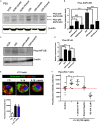Novel Anti-Interleukin-1β Therapy Preserves Retinal Integrity: A Longitudinal Investigation Using OCT Imaging and Automated Retinal Segmentation in Small Rodents
- PMID: 32226385
- PMCID: PMC7081735
- DOI: 10.3389/fphar.2020.00296
Novel Anti-Interleukin-1β Therapy Preserves Retinal Integrity: A Longitudinal Investigation Using OCT Imaging and Automated Retinal Segmentation in Small Rodents
Abstract
Retinopathy of prematurity (ROP) is the leading cause of blindness in neonates. Inflammation, in particular interleukin-1β (IL-1β), is increased in early stages of the disorder, and contributes to inner and outer retinal vasoobliteration in the oxygen-induced retinopathy (OIR) model of ROP. A small peptide antagonist of IL-1 receptor, composed of the amino acid sequence, rytvela, has been shown to exert beneficial anti-inflammatory effects without compromising immunovigilance-related NF-κB in reproductive tissues. We conducted a longitudinal study to determine the efficacy of "rytvela" in preserving the integrity of the retina in OIR model, using optical coherence tomography (OCT) which provides high-resolution cross-sectional imaging of ocular structures in vivo. Sprague-Dawley rats subjected to OIR and treated or not with "rytvela" were compared to IL-1 receptor antagonist (Kineret). OCT imaging and custom automated segmentation algorithm used to measure retinal thickness (RT) were obtained at P14 and P30; gold-standard immunohistochemistry (IHC) was used to confirm retinal anatomical changes. OCT revealed significant retinal thinning in untreated animals by P30, confirmed by IHC; these changes were coherently associated with increased apoptosis. Both rytvela and Kineret subsided apoptosis and preserved RT. As anticipated, Kineret diminished both SAPK/JNK and NF-κB axes, whereas rytvela selectively abated the former which resulted in preserved monocyte phagocytic function. Altogether, OCT imaging with automated segmentation is a reliable non-invasive approach to study longitudinally retinal pathology in small animal models of retinopathy.
Keywords: anti-interleukin-1β; automated segmentation; kineret; optical coherence tomography; oxygen-induced retinopathy; retina; rytvela; therapy.
Copyright © 2020 Sayah, Zhou, Omri, Mazzaferri, Quiniou, Wirth, Côté, Dabouz, Desjarlais, Costantino and Chemtob.
Figures




References
-
- Beaton L., Mazzaferri J., Lalonde F., Hidalgo-Aguirre M., Descovich D., Lesk M. R., et al. (2015). Non-invasive measurement of choroidal volume change and ocular rigidity through automated segmentation of high-speed OCT imaging. Biomed. Opt. Exp. 6 1694–1706. 10.1364/BOE.6.001694 - DOI - PMC - PubMed
LinkOut - more resources
Full Text Sources
Research Materials

